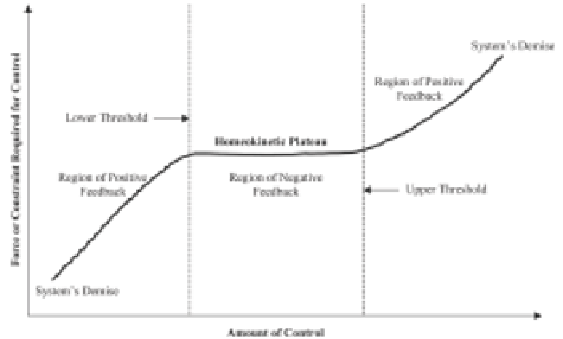Information Technology Reference
In-Depth Information
deteriorates over time and eventually expires indicates that there is a limit to this. Rather
than maintaining its dynamic equilibrium, it is argued that a living system is really in
a state of disequilibrium, a state of evolution termed 'homeokinesis'. Rather than being
a living system's normal state, homeostasis is the ideal or climax state that the system
is trying to achieve, but that is never actually achievable. Homeostasis can be described
in homeokinetic terms as a 'homeokinetic plateau' (Figure 11.3) - the region within
which negative feedback dominates in the living system. In human physiology, after
age 25 (the physiological climax state), the body starts to deteriorate but can still function.
After achieving maturity, it seems that a living system has more factors and contingencies
to deal with, and that require more energy and effort to keep under control. Beyond the
'upper threshold' (see Figure 11.3), it is apparent that the system is again operating in
a positive feedback region, and is deteriorating. Even though the living system is trying
its best to maintain its viability, this effort, nonetheless, cannot counterbalance or defeat
the entropically increasing trend. The system gradually and continuously loses its integ-
ration and proper functioning, which eventually results in the system's expiry.
Although we argue that the concept of homeokinesis and net positive feedback can also
be applied to the explanation of deterioration and demise in organisations, as noted
earlier it is very difficult to make a direct homology between changes in organisms and
changes in organisations. Rather than being biological machines, which can be described
and explained, to a large extent if not (arguably) completely, in terms of physics and
chemistry, organisations are much more complex socio-technical systems comprising
ensembles of people, artefacts, and technology working together in an organised manner.
Figure 11.3. Control requires that the system be maintained within the bounds
of the homokinetic plateau. Adapted from Van Gigch (1991).
As mentioned earlier, after its maturity, the organism gradually and continuously loses
its ability to keep its integration and organisation under control (to counterbalance the
entropically increasing trend) and this finally leads to its demise. While this phenomenon
is normal in biological systems, even though organisations in general may experience
decline and death (as many empires and civilisations did in history), it appears that the
entropic process in organisations is less definite and more complicated than that in or-
ganisms. Kiel (1991) suggests that this dissimilarity can be explained in terms of systems'
differences in their abilities to extract and utilise energy, and the capacity to reorganise
as a result of unexpected and chaotic contextual factors. This suggests that biological
systems are less resilient and capable than social systems with respect to natural decline.

Search WWH ::

Custom Search